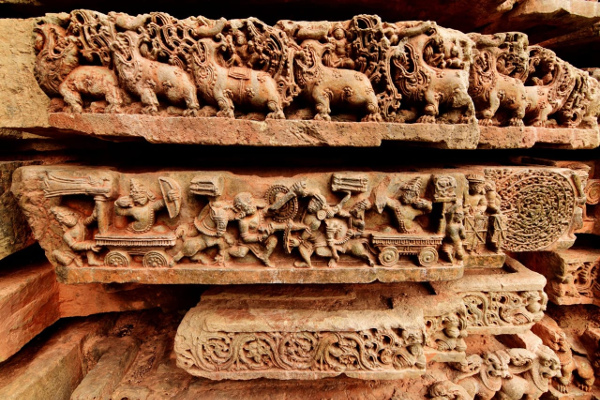NEW DELHI: Carbon dating tests have confirmed that India’s largest known necropolis in UP’s Sanauli — where 126 burials have been discovered until now — is 3,800 years old. The elaborate burials, which included underground chambers, decorated legged coffins and rice in pots buried with the bodies, belong to an indigenous warrior tribe which inhabited the region, according to the Archaeological Survey of India (ASI).
Excavations in Sanauli, 68 km from Delhi in UP’s Baghpat district, started first in 2005 and resumed in 2018, paving the way for discovery of horse-drawn chariots, burials, four-legged wooden coffins, pottery, a copper antenna sword, war shields.
ASI joint director S K Manjul, who led the excavations at Sanauli, told TOI that carbon dating has now confirmed that the burials date back to 1900 BC. “Between 2005 and 2006, 116 burials were found while 10 more were discovered in the last two years, making it India’s largest known necropolis.” The burial pits had legged coffins along with systematically arranged vases, bowls and pots. One of the coffins was decorated with eight anthropomorphic figures.
A recent report submitted by the Birbal Sahni Institute of Paleosciences in Lucknow to the ASI had said that there are two C-14 (carbon dating) dates — 3815 and 3500, with a margin of error of 130 years — for the Sanauli site. It added, “Carbon dating marks this site as an earliest history of a warrior tribe in the Indian subcontinent (sic).”
While the Deccan College, Pune, and a lab in Hyderabad conducted DNA tests of the human remains, samples were also sent to the Lucknow institute. Scientific techniques such as photogrammetry and ground penetrating radar survey were used while drones and magnetometers were also deployed.
The burials bear similarity to Vedic rituals, said officials. “What is startling is the impressions of cloth found on bodies that suggests purification of bodies similar to what we practice in Hindu religion,” said Manjul.
The joint director added that three chariots found at the site “have a fixed axle linked by a long pole to the small yoke” and were run by a pair of animals. “The size and shape of the chariots indicate they were pulled by horses. The axle, chassis and wheels show similarities to contemporary chariots,” he said.
Upinder Kaur, who teaches history at Ashoka University and was earlier in DU, said that the discovery of elaborate burials and remains of chariots was “dramatic and unique”. Talking to TOI, she said, “Just how this evidence fits into the cultural jigsaw puzzle of the 2nd millennium BC drawn from texts and archaeology is something that has to be carefully examined. I am looking forward to reading the detailed report of the Sanauli excavations.”
Historian B R Mani, who oversaw excavations in Sanauli in 2005, said that the site should be looked at “as an interaction of a period of practices of Ganga Yamuna Doab and Indus Valley cultures.”
Why Sanauli is key to ancient Indian history?
Discovery of chariots reveal indigenous warrior tribe
126 burials makes it largest necropolis of chalco-lithic period
Anthropomorphic figures on coffin indicate religious belief
Gold, copper anthropomorphic figure associated with Vedic gods
ASI says Sanaulians (copper hoard people) were warriors
Roots of early historic cultures can be traced here
Materials found here contemporary to late-mature phase of Harappans
Source: ToI
Image Courtesy:IPC
You may also like
-
India Can’t Afford to Remain Stagnant at this Juncture, Says PM Modi; Asks People to Buy Locally-Made Goods
-
Stolen Artefacts to be Returned to India from Scotland Museums
-
Legendary Singer Lata Mangeshkar Passes Away At the Age of 92
-
Netaji’s Hologram Statue at India Gate
-
10th Century Stone Idol of Goat Head Yogini IllegallyRemoved from A Temple in Lokhari, Banda, UP Being Returned to India
